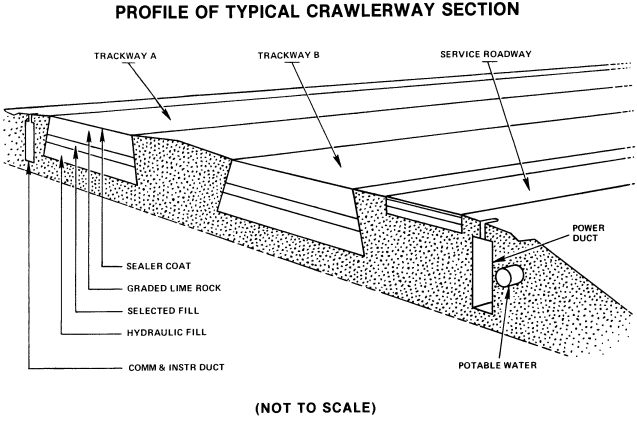
Design of the Crawlerway
While men had moved two- and three - story houses often enough - even some from Merritt Island to the mainland of Florida - no one had ever before moved a skyscraper. Yet that is what the mobile concept called for - or at least an Apollo-Saturn vehicle the size of a skyscraper. The problem was compounded by Merritt Island's marshy terrain and high winds. The combined weight of the crawler-transporter carrying the mobile launcher would exceed 7,700 tons. No one knew what effect such a load would have upon the subsoil of Merritt Island. C. Q. Stewart of the Mechanical Engineering Division had commented on this problem in a memorandum of 1 August 1962 and suggested exploratory borings. He also spurned any type of rigid surface for the crawlerways as too prone to cracking, and urged instead a topping of gravel or crushed stone.29

Typical cross section of crawlerway, as the design took shape in early 1963.
On 1 February 1963, two months after the signing of the URSAM contract, the Detroit firm of Giffels and Rossetti agreed to design the crawlerway and the pads. Three weeks later 19 individuals representing NASA, the Corps of Engineers, and various contracting firms gathered at the LOC for a crawlerway conference. URSAM proposed building the crawlerway of layers with a total thickness of 1.4 meters, topped by crushed stone and a soft grade of asphalt. The Corps of Engineers agreed to compact sand to a depth of 7.6 meters below the pavement by vibroflotation in the areas adjacent to the VAB.30
At another meeting at the Cape on 27 March 1963, representatives of Giffels and Rossetti discussed the crawlerway with representatives of NASA, URSAM, the Corps of Engineers, Marion Power Shovel, and Brown Engineering Company. Donald Buchanan of LOC and one of the Marion representatives objected to the proposed use of an asphalt surface for the crawlerway. They feared that the asphalt would adhere to the treads of the crawler-transporter and cause severe wear of the road surface. The conferees then established two criteria for selecting materials: the surface material should not adhere to the crawler's treads and the coefficient of friction of the materials should not exceed 0.3 under the expected operating temperature range.31
During the next few months there were more meetings, one in Jacksonville on 27 June, another in Detroit on 14 August. At the former the Marion Power Shovel representative discussed the limits of friction. The conferees determined that the crawler would break up any type of hard surface, and the best surface would be crushed stone - as Stewart had suggested a year before. After the latter meeting, J. B. Bing of the LOC programming office reported that there had been absolutely no coordination between Giffels and Rossetti and URSAM, even though their respective areas of design had an obviously close relationship.32
In the fall of 1963, eight representatives from LOC and the Corps of Engineers formed the "Construction Coordination Group for Complex 39"; the group's purpose was to manage the details of construction at the launch complex. The chairman briefed members on the construction status, problems, delivery of materials, and the impact of each change on critical construction schedules and contract costs. The scope of the group's work included scheduling, processing of changes, quality requirements, and funding. The Construction Coordination Group commenced operation immediately and was to continue until the completion of major Corps construction on complex 39.33
| Next |